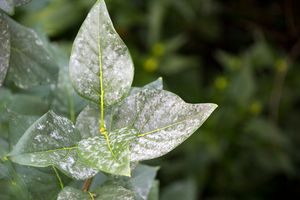Powdery Mildew
Mirjana Bulatovic-Danilovich, WVU Extension Specialist, Consumer Horticulture – Agriculture & Natural Resources
What is Powdery Mildew?
Powdery mildew is a fungal disease commonly found on a variety of plants. Fungal spores overwinter in infected buds, shoots, leaf scars and in plant debris on the ground. Powdery mildew can present a problem on fruit trees, vegetables, ornamentals and forest trees. Though the symptoms of powdery mildew look the same on different plants, the fungus is species-specific. Therefore, powdery mildew from a sycamore tree is not going to spread to a rose bush or to Bermuda grass. High relative humidity and temperatures from 60 to 80° F favor powdery mildew development. Temperatures below 50° F and above 90° F will significantly curb the disease.
 What does it look like?
What does it look like?
Powdery mildew is characterized by white, flour-like patches on the leaves, flowers, fruits and terminal shoots. These lesions spread rapidly and can completely cover both the leaves and shoots. Infected leaves are smaller/narrower, fold upward and become brittle.
What problems does it cause?
Powdery mildew can reduce yields of fruits and vegetables by attacking their buds, flowers and shoots. It also impacts the quality and marketability of fruits and vegetables due to unsightly scars it can cause on their skin. Additionally it is aesthetically undesirable when it attacks ornamentals, leaving them looking sickly and discolored.
What can be done about it?
Even though it is unattractive, powdery mildew on ornamentals does not necessarily require a treatment. But since the disease can diminish the productivity of fruit and vegetable plants, there are several maintenance approaches that can prevent and/or reduce this disease.
- Water your plants in the morning so that the water has time to evaporate and the leaves have time to dry.
- Use a soaking hose rather than an overhead sprinkling system that keeps the leaves wet.
- Prune your trees and shrubs to open up the canopy for better air movement, allowing faster drying conditions.
- Since powdery mildew attacks young tissue, avoid applying nitrogen fertilizer late in the season so that you do not prolong or even restart vegetative growth. This will minimize the possibility of having powdery mildew issues in the later part of the season.
- On rare occasions, sulfur-based fungicides will be needed during the period of active plant growth. In apples, for example, this period would be from tight cluster until the terminal buds are set.
- Besides sulfur, another organic approach would be spraying with a baking soda solution (1 teaspoon of baking soda in 1 quart of water). The goal is to change the pH and create a more neutral to alkaline environment unsuitable for fungus growth.
- Neem oil or some horticultural oils (Sunspray® Ultra-Fine® Spray Oil, Saf-T-Side® Spray Oil, etc.) may also be effective by creating a film on the surface of the leaves unsuitable for fungal growth. Never apply oil sprays within 2 weeks of sulfur application or plant injury will occur. Do not spray oil if the air temperature is well above 80° F or the plant tissue will be damaged (oils can burn the leaves if applied on hot days).
- Practice good sanitation by removing and destroying all infected parts of the plant (leaves, branches, vines and infected fruit). Do not put them on your compost pile, since the fungus might survive if the temperature within the pile is not high enough to kill the fungus.
Recommendations for the use of agricultural chemicals are included as a convenience to the reader. The use of brand names and any mention or listing of commercial products or services in this fact sheet does not imply endorsement by West Virginia University Extension Service nor discrimination against similar products or services not mentioned. Individuals who use agricultural chemicals are responsible for ensuring that the intended use complies with current regulations and conforms to the product label. Be sure to obtain current information about usage regulations and examine a current product label before applying any chemical. For assistance, contact your county Cooperative Extension agent.